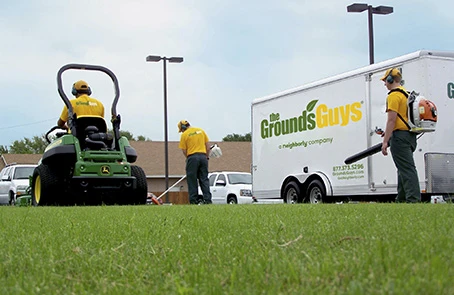Lawn aeration is crucial for a healthy, flourishing lawn. It involves perforating the soil with small holes, allowing for better air, water, and nutrient penetration into the root zone of the grass. Lawn aeration helps improve issues like soil compaction, excessive thatch buildup, and poor root growth.
Aeration is essential for several reasons:
- Improved Air Circulation. It improves the exchange of gases between the soil and the atmosphere. This promotes healthier root development and overall grass vitality.
- Enhanced Water Absorption. Aeration reduces surface runoff and allows water to penetrate deeper into the soil. This prevents waterlogged areas and promotes even moisture distribution.
- Nutrient Uptake. It facilitates the delivery of essential nutrients to the grassroots. This ensures better nutrient absorption and utilization.
- Thatch Reduction. Aeration helps break down and reduce thatch, which is a layer of dead grass and organic matter that can suffocate the lawn.
- Stronger Roots. The improved growing conditions encourage robust root growth. This makes the lawn more resilient to stressors like drought and disease.
- Better Overall Lawn Health. Aeration contributes to a healthier and visually appealing lawn.
When Is the Best Time to Aerate Your Lawn?
The best time to aerate your lawn in Sparks, NV, is early fall and early spring. In Sparks, NV, cool-season grasses like tall fescue, perennial ryegrass, and buffalograss are prevalent. These grasses usually grow during the warm summer months. So, it's best to avoid aeration during the peak of summer to prevent stress on the grass and your turf.
Generally, there are two primary aeration periods:
Early Fall
Fall is often considered the best time for lawn aeration in Sparks, NV. During this season, the soil is still warm, which promotes healthy root growth, and the cooler temperatures reduce stress on the grass. Aeration in early fall allows the grass to recover and develop strong roots before winter.
Early Spring
Early spring, just before the growing season begins, is another suitable time for lawn aeration. However, be cautious not to aerate too late in the spring, as it can disrupt the active growth of warm season grasses common in the region.
We offer free job estimates — we can assess your lawn and offer our professional opinion and advice. Contact us online for a free job estimate today!
Our Value of C.A.R.E.
At The Grounds Guys of Sparks, NV, our C.A.R.E. values are at the heart of everything we do. Customer's First means your satisfaction is our top priority. Attitude reflects our positive and can-do approach to every lawn aeration project. Respect is a fundamental principle, treating both you and our team members with dignity. We also believe in enjoying life in the process and finding fulfillment in the work we do. With these values, we promise to deliver exceptional service while embracing the joy of landscaping and caring for your needs.
Lawn Aeration FAQ
How long do you have to stay off the lawn after aeration?
After aeration, it's best to stay off the lawn for at least 24 to 48 hours to allow the soil to settle and recover. This ensures that the holes created by the aeration process have time to fill in naturally, promoting healthy grass growth.
What should you do before aerating your lawn?
Here are some key steps to take before aerating your lawn:
- Watering. Water your lawn thoroughly 24 to 48 hours before aeration. Moist soil cores are easier to penetrate and will settle back into the holes more effectively.
- Mowing. Mow your lawn to a short height (2 to 3 inches) a few days before aeration. This allows the aeration equipment to move smoothly and reduces the risk of damaging grass blades.
- Marking Underground Utilities. Mark any obstacles like sprinkler heads or underground utilities to avoid damaging them during aeration.
- Clear the Area. Remove any furniture, decorations, or toys from the lawn to create a clear workspace for the aeration equipment.
What should you do immediately after an aeration?
Here's what to do after your lawn has been aerated:
- Watering. You may need to water your lawn lightly after aeration, especially if the weather is hot and dry.
- Seeding. If you plan to overseed your lawn, aeration is a great time to do so. The core holes provide ideal seed-to-soil contact for germination.
By following these simple tips, you can ensure a successful lawn aeration process and promote a healthier, more vibrant lawn.
 Click to call
Click to call
 Click to call
Click to call








